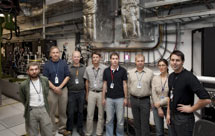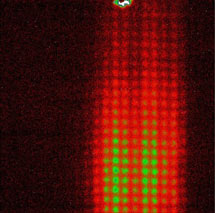
Handy Links
SLAC News Center
SLAC Today
- Subscribe
- Archives: Feb 2006-May 20, 2011
- Archives: May 23, 2011 and later
- Submit Feedback or Story Ideas
- About SLAC Today
SLAC News
Lab News
- Interactions
- Lightsources.org
- ILC NewsLine
- Int'l Science Grid This Week
- Fermilab Today
- Berkeley Lab News
- @brookhaven TODAY
- DOE Pulse
- CERN Courier
- DESY inForm
- US / LHC
SLAC Links
- Emergency
- Safety
- Policy Repository
- Site Entry Form

- Site Maps
- M & O Review
- Computing Status & Calendar
- SLAC Colloquium
- SLACspeak
- SLACspace
- SLAC Logo
- Café Menu
- Flea Market
- Web E-mail
- Marguerite Shuttle
- Discount Commuter Passes
-
Award Reporting Form
- SPIRES
- SciDoc
- Activity Groups
- Library
Stanford
Around the Bay
First Experiments with Third LCLS Instrument Go to the Source
The third round of experiments at the Linac Coherent Light Source began earlier this month at a whole new level of capability. For the first time they included research with the third LCLS instrument, the X-Ray Pump Probe, whose hard X-rays penetrate deeper into matter than the soft X-rays used by the first two instruments. This makes the LCLS XPP unique in the world.
"This is the only place to get hard X-ray laser pulses," said Christian David, a researcher at the Paul Scherrer Institute in Switzerland and principal investigator on the first XPP user run, which wrapped up this week. "That's why we waited for XPP instead of submitting a proposal to any of the other instruments."
David develops instrumentation for large-scale facilities, and is involved in his institution's plans to build a lightsource similar to LCLS. The goal of his XPP experiment was to learn about the X-ray source, or the point at which bunches of photons emerge from the undulator magnets that generate them. To do this, his group measured each pulse's wavefront, essentially the point at which all X-rays in the pulse are traveling in unison.
Their experimental setup included two silicon gratings spaced half a meter apart. The first split the X-rays to create interference patterns with features only a single micron wide. The second, placed in front of the XPP detector, analyzed these patterns.
David said he expects to be able to identify the location of the source with micron resolution transverse to the beam and on the order of one meter along the length of the beam. In addition, he said, the experiments reveal possible distortions of the X-ray wave front introduced by mirrors in the beam path. These insights into the LCLS beam behavior can help future researchers to obtain better LCLS data—for example, by choosing the best possible operating parameters of the source and the optical elements.
"This is useful as a diagnostic tool," David said, suggesting it could become standard on future lightsources. "We can help LCLS see what's going on here, too." He added that he was impressed by the unique capabilities at LCLS as well as the support his group received from LCLS staff.
Toward the end of the run, the group also tested a new type of X-ray lens made of diamond, one of the few materials that can stand up to the powerful energies of hard X-rays. David speculates that they were able to focus the beam down to a spot size 10 times smaller than achieved before. But the real triumph was the density of that spot.
"I don't think that anyone has ever been able to get that kind of X-ray intensity into one place before," he said
While David and his group did not take advantage of XPP's eponymous "pump-probe" technique—in which one pulse manipulates a sample and a second pulse scatters photons off the sample to form an image—David said he hopes that "all the other experiments after ours can benefit from the results we obtain, to make LCLS an even more fascinating, powerful facility."
—Lauren Rugani
SLAC Today, October 22, 2010

